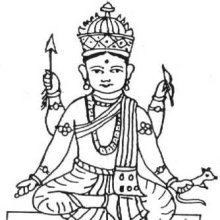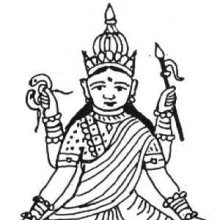Manavi, Māṇavī, Manāvī, Māṇavi, Māṉāvi: 18 definitions
Introduction:
Manavi means something in Hinduism, Sanskrit, Jainism, Prakrit, Buddhism, Pali, Marathi, Hindi, Tamil. If you want to know the exact meaning, history, etymology or English translation of this term then check out the descriptions on this page. Add your comment or reference to a book if you want to contribute to this summary article.
Alternative spellings of this word include Manvi.
Images (photo gallery)
In Hinduism
Purana and Itihasa (epic history)
Source: archive.org: Puranic EncyclopediaMānavī (मानवी).—A prominent river of ancient India. (Śloka 32, Chapter 9, Bhīṣma Parva).
Source: JatLand: List of Mahabharata people and placesMānavī (मानवी) refers to the name of a River mentioned in the Mahābhārata (cf. VI.10.31). Note: The Mahābhārata (mentioning Mānavī) is a Sanskrit epic poem consisting of 100,000 ślokas (metrical verses) and is over 2000 years old.

The Purana (पुराण, purāṇas) refers to Sanskrit literature preserving ancient India’s vast cultural history, including historical legends, religious ceremonies, various arts and sciences. The eighteen mahapuranas total over 400,000 shlokas (metrical couplets) and date to at least several centuries BCE.
In Jainism
General definition (in Jainism)
Source: archive.org: The Jaina Iconography1) Mānavī (मानवी) or Aśokā is the name of the Yakṣiṇī accompanying Śītalanātha: the tenth of twenty-four Tīrthaṃkaras or Jinas, commonly depicted in Jaina iconography.—[...] The image of the Śvetāmbara Yakṣiṇī Aśokā is described as seated upon a lotus and bearing in her hands Varada, noose, fruit and goad. The Digambara books describe Mānavī as riding a hog and holding the attributes, as follows, fruit, Vara, bow, etc. Like the majority of Yakṣiṇīs, the Yakṣiṇī, in question, has a dual aspect, she is in one aspect a Yakṣiṇī and in another, a Vidyādevī. As Vidyādevī, her name is Mānavī and she is described as seated on a blue lotus. Here, also as a pure Yakṣiṇī, the Śvetāmbara accounts give her a blue lotus. The war-like attributes like a goad, noose, bow are symbols quite befitting her characteristic of a Yakṣiṇī or Guardian angel. The benign symbols, such as, Varada, fruit and a blue-lotus seat she is given, however, would make us recognise in her a form of Vidyādevī or goddess of learning.
2) Mānavī (मानवी) (or Gaurī, Śrīvatsā-Devī) is also the Yakṣiṇī accompanying Śreyāṃśanātha: the eleventh of twenty-four Tīrthaṃkaras.—[...] This eleventh Yakṣiṇī belongs to the eleventh Tīrthaṃkara Śreyāṃśanātha. The Digambara representation of the Yakṣiṇī known therein as Gaurī rides, according to their accounts, anantelope and bears a club, lotus, urn and Varada in her hands. The Śvetāmbara variant of the same Yakṣi in the name of Mānavī or Śrīvatsā Devī has been described as riding a lion and holding a Varada club, urn and goad. The name Gaurī originates evidently from the Brahmanic Gaurī, the wife of Śiva. Here, in this instance, the Yakṣa, of whom Gaurī is the consort is called Īśvara. Her other aspect is represented by a Vidyādevī, known by the same name.
Now, the Śvetāmbaras give her the name of Śrīvatsā or Mānavī. This name, however, presents an anomaly due to the identity of Mānavī with the Digambara Yakṣiṇī, of Śītalanātha bearing the same name. Thus, it is possible to explain the name Śrīvatsā as originating from the Śrīvatsā figure, the canonical symbol of Śītalanātha. As regards the attributes, which adorn the hands of the Devī some of them are war-like, as worthy of a Yakṣiṇī, and others are benign, as symbolic of a goddess of learning.
3) Mānavī (मानवी) also refers to one of the sixteen Vidyādevīs (goddesses of learning).—According to one text, Mānavī has blue colour and sits on a blue lotus and a twig. According to another of the same Śvetāmbara school, she sits on a lotus and is four-handed showing Varada, rosary and a bough of a tree. The Digambara text also describes her as of blue colour and as riding a boar and bearing a trident. The Vidyādevī has a parallel in name to the Śvetāmbara Yakṣiṇī of Śreyāṃsanātha and in the Digambara Yakṣiṇī of Śītalanātha. The former parallel does not seem to be of form but of mere name. Śītalanātha’s Yakṣiṇī as admitted by the Digambara school presents a similarity of name and vehicle. Stress has been laid on the Vidyādevī’s colour being blue and in this connection, one is led to trace some faint relation between her and the Nīlasarasvatī of Brahmanism. The boar symbol would connect the female deity with Vārāhī having the same vehicle.
Source: archive.org: Trisastisalakapurusacaritra1) Mānavī (मानवी) or Mānavīvidyā refers to one of the sixteen Vidyās from which are derived the respective classes of Vidyādharas (in this case, Mānava), according to chapter 1.3 [ādīśvara-caritra] of Hemacandra’s 11th century Triṣaṣṭiśalākāpuruṣacaritra: an ancient Sanskrit epic poem narrating the history and legends of sixty-three illustrious persons in Jainism.
Accordingly, “[...] After making [the two rows of Vidyādhara-cities], many villages and suburbs, they established communities [viz., the Mānavas] according to the suitability of place. [...] Dharaṇendra instructed them about the law as follows: ‘If any insolent persons show disrespect or do injury to the Jinas, or the Jinas’ shrines, or to those who will attain mokṣa in this birth, or to any ascetics engaged in pratimā, the Vidyās [viz., Mānavīs] will abandon them at once, just as wealth abandons lazy people. Whoever kills a man with his wife, or enjoys women against their will, the Vidyās will abandon him at once’.”
2) Mānavī (मानवी) is the name of the Yakṣiṇī (śāsanadevatās, ‘messenger-deities’) associated with Śreyāṃsa, according to chapter 4.1 [śreyāṃsanātha-caritra].—Accordingly, “A Yakṣa, originating in the congregation, named Īśvara, three-eyed, white, with a bull for a vehicle, with one right hand holding a citron and a second holding a club, with an ichneumon and a rosary in his left hands, became Lord Śreyāṃsa’s messenger-deity at that time. Likewise the goddess Mānavī, fair, with a lion for a vehicle, with one right hand in the boon-granting position and one holding a hammer, holding a thunder-bolt and a goad in her left hands, became the Lord’s attendant messenger-deity at that time”.

Jainism is an Indian religion of Dharma whose doctrine revolves around harmlessness (ahimsa) towards every living being. The two major branches (Digambara and Svetambara) of Jainism stimulate self-control (or, shramana, ‘self-reliance’) and spiritual development through a path of peace for the soul to progess to the ultimate goal.
Languages of India and abroad
Pali-English dictionary
Source: BuddhaSasana: Concise Pali-English Dictionarymāṇavī : (f.) a maiden.

Pali is the language of the Tipiṭaka, which is the sacred canon of Theravāda Buddhism and contains much of the Buddha’s speech. Closeley related to Sanskrit, both languages are used interchangeably between religions.
Marathi-English dictionary
Source: DDSA: The Molesworth Marathi and English Dictionarymānavī (मानवी).—f S A woman or female.
--- OR ---
mānavī (मानवी).—a S Human, pertaining or relating to man.
Source: DDSA: The Aryabhusan school dictionary, Marathi-Englishmānavī (मानवी).—a Human. f A woman.
Marathi is an Indo-European language having over 70 million native speakers people in (predominantly) Maharashtra India. Marathi, like many other Indo-Aryan languages, evolved from early forms of Prakrit, which itself is a subset of Sanskrit, one of the most ancient languages of the world.
Sanskrit dictionary
Source: DDSA: The practical Sanskrit-English dictionaryManāvī (मनावी).—The wife of Manu.
See also (synonyms): manāyī.
Source: Cologne Digital Sanskrit Dictionaries: Cappeller Sanskrit-English DictionaryManāvī (मनावी).—[feminine] = manāyī.
Source: Cologne Digital Sanskrit Dictionaries: Monier-Williams Sanskrit-English Dictionary1) Manāvī (मनावी):—[from man] f. ([from] manu) Manu’s wife, [Śatapatha-brāhmaṇa] (cf. manāyī).
2) Mānavī (मानवी):—[from mānava] f. a daughter of man, a woman, [Ṛg-veda] etc. etc.
3) [v.s. ...] Jasminum Auriculatum, [cf. Lexicographers, esp. such as amarasiṃha, halāyudha, hemacandra, etc.]
4) [v.s. ...] Name of a Vidyā-devī, [cf. Lexicographers, esp. such as amarasiṃha, halāyudha, hemacandra, etc.]
5) [v.s. ...] of a goddess (executing the commands of the 11th Arhat of the present Avasarpiṇī), [cf. Lexicographers, esp. such as amarasiṃha, halāyudha, hemacandra, etc.]
6) [v.s. ...] of a river, [Mahābhārata] ([varia lectio] tānsasī)
7) [v.s. ...] [plural] Name of [particular] verses, [Gautama-dharma-śāstra]
Source: DDSA: Paia-sadda-mahannavo; a comprehensive Prakrit Hindi dictionary (S)Mānavī (मानवी) in the Sanskrit language is related to the Prakrit word: Māṇavī.
[Sanskrit to German]
Sanskrit, also spelled संस्कृतम् (saṃskṛtam), is an ancient language of India commonly seen as the grandmother of the Indo-European language family (even English!). Closely allied with Prakrit and Pali, Sanskrit is more exhaustive in both grammar and terms and has the most extensive collection of literature in the world, greatly surpassing its sister-languages Greek and Latin.
Hindi dictionary
Source: DDSA: A practical Hindi-English dictionaryMānavī (मानवी) [Also spelled manvi]:—(a) see [mānavīya]; (nf) a woman.
...
Prakrit-English dictionary
Source: DDSA: Paia-sadda-mahannavo; a comprehensive Prakrit Hindi dictionaryMāṇavī (माणवी) in the Prakrit language is related to the Sanskrit word: Mānavī.
Prakrit is an ancient language closely associated with both Pali and Sanskrit. Jain literature is often composed in this language or sub-dialects, such as the Agamas and their commentaries which are written in Ardhamagadhi and Maharashtri Prakrit. The earliest extant texts can be dated to as early as the 4th century BCE although core portions might be older.
Kannada-English dictionary
Source: Alar: Kannada-English corpusManavi (ಮನವಿ):—
1) [noun] a request for help, sympathy, etc.; an appeal.
2) [noun] a written application made in this regard.
--- OR ---
Manavī (ಮನವೀ):—
1) [verb] to pay attention to.
2) [verb] to wish, desire for.
--- OR ---
Mānavi (ಮಾನವಿ):—[noun] a female human being.
Kannada is a Dravidian language (as opposed to the Indo-European language family) mainly spoken in the southwestern region of India.
Nepali dictionary
Source: unoes: Nepali-English DictionaryMānavī (मानवी):—adj. pertaining to human beings; n. woman female;
Nepali is the primary language of the Nepalese people counting almost 20 million native speakers. The country of Nepal is situated in the Himalaya mountain range to the north of India.
See also (Relevant definitions)
Starts with (+11): Mana-viralvel, Manavibheda, Manavicam, Manavicanam, Manavidara, Manavidu, Manavihara, Manavijaya, Manavika, Manavikarana, Manaviki, Manaviki-ra-samajika-shastra, Manaviki-ra-samajika-shastra-adhyayana-samsthana, Manavikikrida, Manavikku, Manavikramasamutiricari, Manavikramasamutirichari, Manavikrayin, Manavili, Manaviluhu.
Ends with: Amanavi, Melmanavi.
Full-text (+11): Manayi, Manvi, Manave, Manuve, Manu, Jalapa, Kaitabhahan, Kaitabharipu, Manava, Ashoka, Shrivatsa, Manavividya, Au, Tripishta, Gauri, Aida, Tindaka, Yaksheta, Ishvara, Bilva.
Relevant text
Search found 17 books and stories containing Manavi, Maanaavi, Maanavi, Māṇavī, Mānavī, Manāvī, Manavī, Mānavi, Māṇavi, Māṉāvi; (plurals include: Manavis, Maanaavis, Maanavis, Māṇavīs, Mānavīs, Manāvīs, Manavīs, Mānavis, Māṇavis, Māṉāvis). You can also click to the full overview containing English textual excerpts. Below are direct links for the most relevant articles:
Vasudevavijaya of Vasudeva (Study) (by Sajitha. A)
Strīpratyaya (Feminine affixes) < [Chapter 3 - Vāsudevavijaya—A Grammatical Study]
Poetic charm in Vāsudevavijaya < [Chapter 4 - Vāsudevavijaya—A Literary Appreciation]
Rig Veda (translation and commentary) (by H. H. Wilson)
Jainism in Odisha (Orissa) (by Ashis Ranjan Sahoo)
Iconography of Jain Gods and Goddess < [Chapter 6]
Iconography of Sasanadevis < [Chapter 6]
Jain Remains of Ancient Bengal (by Shubha Majumder)
The twenty-four Tīrthaṅkaras and their Yakṣas and Yakṣiṇīs < [Chapter 6 - Iconographic Study of Jaina Sculptural Remains]
List of Mahabharata people and places (by Laxman Burdak)
Trishashti Shalaka Purusha Caritra (by Helen M. Johnson)
Part 25: Śreyāṃsa’s śāsanadevatās (messenger-deities) < [Chapter I - Śreyāṃsanāthacaritra]
Part 5: Description of Vaitāḍhya < [Chapter III]

